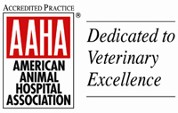Did you know that dental disease begins as soon as your pet has teeth? Plaque and tartar buildup start immediately. Understanding WHY taking care of a pet’s teeth at home is so important goes a long way to giving your pets the life they deserve.
The power of plaque and tartar
Plaque is a strong sticky film of bacteria that builds up on your pet’s teeth, releasing acids and causing gum inflammation when exposed to food. It can be removed fairly well with careful brushing but if not—in as little as 24 hours—it will bind with minerals like calcium in the saliva to form tartar, a hardened version of plaque that can’t be brushed off. In fact, tartar is the brown stuff you may see on your pet’s teeth and is what the veterinary dental hygienist scrapes off when your pet has a dental cleaning.
The thing about tartar is that it provides a nice sticky surface for more plaque to form. In other words, plaque leads to tartar…which encourages more plaque and tartar. As the cycle continues, thick tartar buildup will lift the gums and allow bacteria to move under the surface where they escape all tooth-brushing efforts. Once bacteria are tucked under the gums, they break down the soft tissues and even the bone around the tooth. This causes inflammation and pain and can even result in infection entering the bloodstream and affecting major organs like the heart, kidneys, and liver.
Oral home care and a COHAT go hand-in-hand
Because dental disease is constantly progressing in a pet’s mouth, we recommend your pet have a complete oral health assessment and treatment (COHAT) every year, similar to the yearly check-up and cleaning you may have with your dentist. During a COHAT your pet will:
- Have a complete oral examination: the only way to completely examine your pet’s mouth is when they are asleep.
- Have dental x-rays (radiographs) performed to look for concerns under the gumline that cannot be seen during a visual examination.
- Have their teeth cleaned. This means removing every bit of tartar from their teeth including, most importantly, from under the gumline.
- Have their teeth polished to reduce plaque reformation.
- Receive any treatment needed based on the above COHAT.
Here’s what you can do at home to help your pet’s oral health
Brushing
By attacking dental disease at the beginning of the plaque-tartar cycle, brushing daily or every other day is the best way to slow the progression of dental disease. The less plaque on your pet’s teeth, the slower tartar builds up. Brushing your dog or cat’s teeth is almost as easy as your own…if they cooperate! Patience is key.
Steps to brushing:
- Don’t rush to brush – get your pet used to it first.
- Ideally start when your pet is young, before they get their adult teeth.
- Daily, while your pet is relaxing, lift their lips to look at their teeth while talking calmly to them. Depending on how relaxed they are, this may be just lifting one lip to look at their large canine tooth (fang). Then start to ask for a little more each day, until you can see all the teeth in your pet’s mouth. Every time you do this, say thank you with a treat or cuddle reward.
- Once they are relaxed with the above process, start again but use a wet gauze, wet cotton swab (small dogs/cats) or a wet toothbrush to wipe the outside of the teeth. You can use tuna juice or other tasty liquid to make this more acceptable.
- Focus on wiping or brushing along the gumline.
- Toothpaste made for dogs and cats can be used to enhance the cleaning—ask us for our recommendation.
- Another option for “brushing” is to use dental wipes infused with treatments that can help repel plaque.
If your pet has signs of gingivitis, brushing can be painful—your pet should receive a COHAT before you start brushing their teeth!
Dental diets
When it comes to oral health care, dry foods are not created equal. There are many diets, such as Royal Canin Dental and Hills t/d, are specifically designed to reduce plaque, with some proven to reduce tartar. Many work by way of their kibble design; instead of shattering when bitten, the kibble withstands penetration by the tooth and scrapes away plaque as the pet chews.
Dental chews
Similar to the abrasive action of kibble in dental diets, dental chews can also help remove plaque from a pet’s teeth.
Take note: As pets don’t chew with all their teeth, dental diets and chews will miss areas of the mouth. They are not a replacement for regular teeth brushing.
Water additives, gels and sprays
While these products lack the abrasive action offered by chews, dental diets, and brushing, these products still have benefit, acting like a mouthwash to reduce oral bacteria and plaque buildup. Don’t wait for your pet’s next appointment – ask the team at Old Towne Animal Hospital for our favourite products for oral health.
How can I know which products work, which are a waste of money, and which are potentially dangerous?
The Veterinary Oral Health Council (VOHC) (an independent organization) has developed set standards and testing protocols that manufacturers can use to prove their products, including diets, are effective at reducing dental disease. Look for the VOHC seal on anything you purchase for your pet’s dental health.
Another good rule to follow is, “If you wouldn’t want to hit yourself in the kneecap with it, don’t give it to your dog,” (aka the Kneecap rule). Hard chews like bones, antlers and even hard nylon chews can break your dog’s teeth, causing pain, infection, and costly treatment.
It’s important to remember that
- There are no dental products that treat dental disease; they only slow its progression.
- Following a home dental care routine gives your pet helps to slow the progression of dental disease.
- A home dental care routine will not eliminate your pet’s need for a COHAT, but it will reduce the risk of your pet needing extractions or other advanced dental treatments if home care is paired with regular COHATs.
Talk to the team at Old Towne Animal Hospital today about starting a dental care program for your pet. We can help you determine what will work best for you and your pet.


